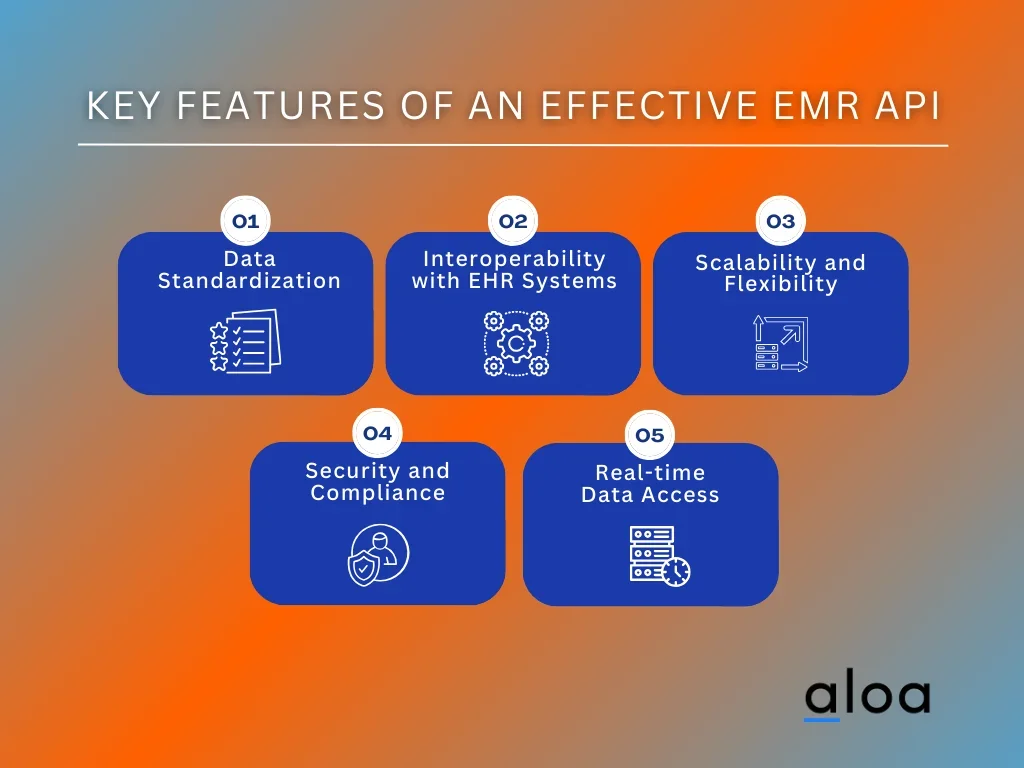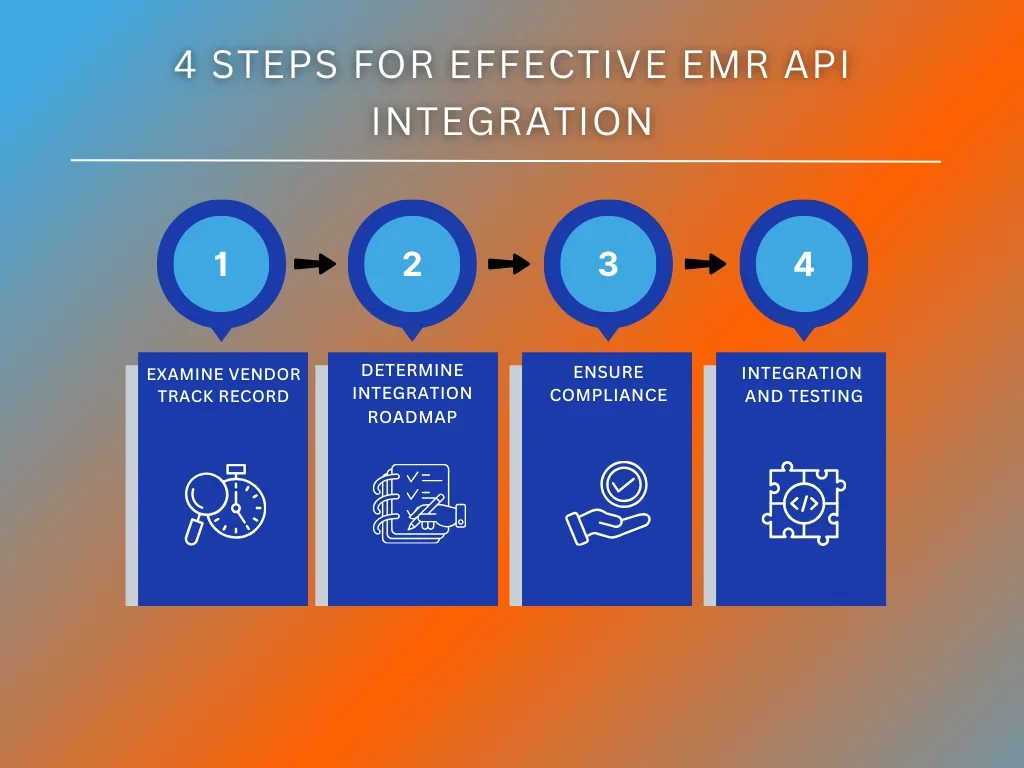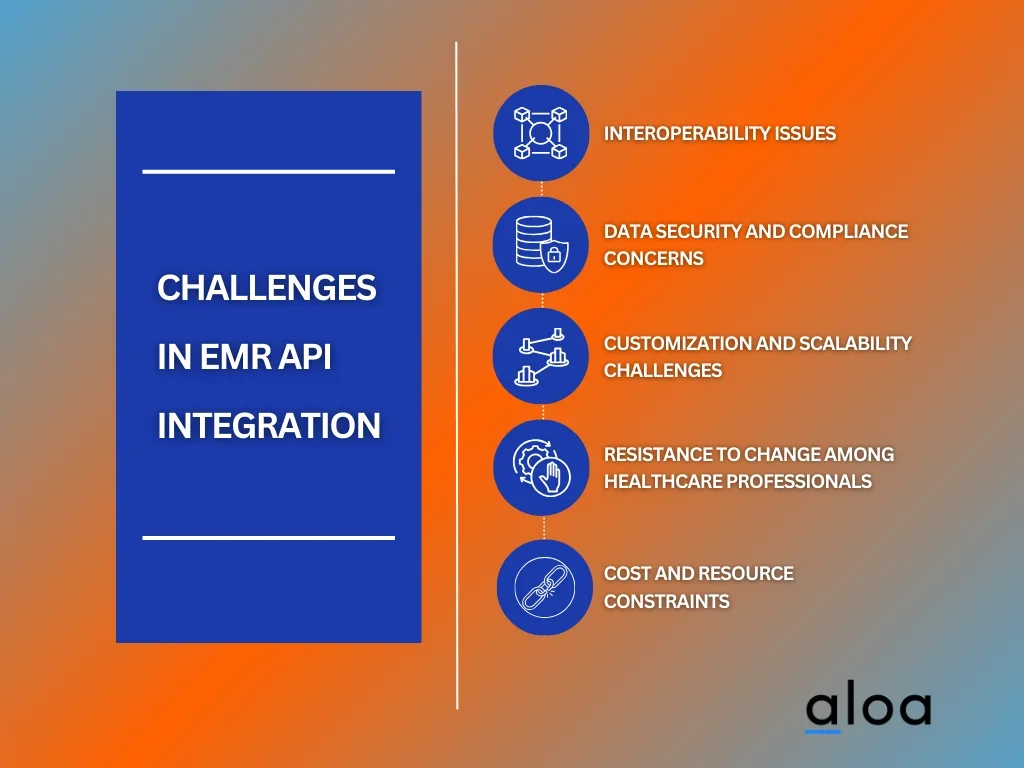In the HealthTech industry, EMR API integration is crucial in revolutionizing patient care and healthcare documentation. This technological bridge fosters seamless communication within electronic medical records systems, ensuring the swift and secure transfer of vital patient information. The transformative impact of EMR integration is felt across the industry, enhancing efficiency and streamlining processes for healthcare providers.
Aloa understands the intricate challenges businesses and startups face in navigating the complexities of EMR API integration. By providing tailored solutions, Aloa assists organizations in optimizing their healthcare systems, ensuring the secure handling and customization of patient data. Integrating APIs for EMR systems becomes a strategic move for these entities, granting them a competitive edge in HealthTech industry.
In this blog, we delve into the intricacies of API integrations for EMR systems, from understanding its key features to practical applications in the HealthTech sector. We will navigate the selection criteria, challenges, and benefits of effective EMR API integration. Afterward, businesses and startups will gain valuable insights into harnessing the power of API integrations for EMR systems for a competitive edge in the ever-evolving HealthTech industry.
Let's get started!
What is EMR API Integration

Electronic Medical Records Integration API is a crucial tool in the HealthTech industry, serving as the backbone for seamless communication within electronic medical records systems. EMR API integration revolutionizes how healthcare data is managed and shared, enhancing the efficiency of HealthTech operations.
At its core, the Electronic Medical Records integration API is a dynamic interface that facilitates the exchange of medical information across diverse platforms. Its key functionalities encompass various data types, allowing various actions to leverage its interconnectedness. Electronic Medical Records integration API is not just a technological solution; it is a transformative force driving the evolution of the HealthTech ecosystem.
In HealthTech, Electronic Medical Records integration API enhances efficiency and precision. It involves the intricate interplay of components that define the seamless integration of electronic medical records. By adopting API integrations for EMR systems, healthcare providers can streamline processes, ensuring that crucial patient data flows seamlessly across different systems.
Key Features of an Effective EMR API

As organizations strive for seamless communication and data interoperability within electronic medical records systems, understanding the critical features of an effective EMR API becomes paramount. Let's explore the core functionalities that are truly transformative in HealthTech.
Data Standardization
An effective API integration for EMR systems begins with the ability to standardize data across different systems. This ensures that information adheres to a standard format regardless of its source. Standardization simplifies the integration process, enabling disparate systems to communicate seamlessly. API integrations for EMR systems are most effective when they are a universal translator, converting data into a standardized language that all involved systems can comprehend.
Interoperability with EHR Systems
The synergy between EMR and EHR (Electronic Health Records) systems is critical. An EMR API should seamlessly integrate with EHR systems, facilitating a holistic patient record. This integration ensures that medical professionals have comprehensive and up-to-date information at their fingertips. Consider variations like ehr integration and ehr API for maximum impact when exploring API integrations for EMR systems functionalities.
Scalability and Flexibility
HealthTech landscapes are dynamic and ever-evolving. An effective EMR API should be scalable, accommodating the growth and changes within healthcare organizations. Whether expanding services or integrating new technologies, the API integrations for EMR systems must adapt without compromising efficiency. Scalability ensures that the system remains robust despite evolving industry demands.
Security and Compliance
With the sensitivity of health data, security is non-negotiable. Effective API integrations for EMR systems prioritize the confidentiality and integrity of patient information. It should adhere to industry standards and regulations, such as HIPAA (Health Insurance Portability and Accountability Act).
Real-time Data Access
In the healthcare realm, time is often of the essence. An effective EMR API provides real-time data access, ensuring healthcare professionals have the most recent information. This real-time functionality enhances decision-making processes, improves patient care, and improves operational efficiency.
4 Steps for Effective EMR API Integration
Integrating Electronic Medical Records (EMR) is a crucial component, enhancing communication and efficiency within the industry. Let's delve into the intricacies of API integrations for EMR systems, outlining a comprehensive approach in four key steps.

Step 1: Examine Vendor Track Record
The initial step of EMR API integration revolves around meticulously examining the vendor's track record. This step is a critical precursor to a successful integration journey, and the following aspects merit a closer look:
Vendor Evaluation
Commence the evaluation process by delving into the vendor's track record.
- Proven Experience: Scrutinize the vendor's history in API integrations for EMR systems. Thoroughly explore case studies and delve into client testimonials to gauge the depth of their success stories.
- Industry Reputation: Conduct a comprehensive investigation into the vendor's standing within the HealthTech sector. Analyze reviews and ratings from reputable sources to ascertain their credibility.
Technical Proficiency
Assessing the technical prowess of the chosen vendor is imperative for a seamless integration process.
- Technology Stack: Ensure that the vendor employs modern and secure technology stacks that align with the requirements of your EMR system.
- Scalability: Evaluate the vendor's capability to scale alongside your organization's growth, ensuring that the chosen solution remains robust and adaptable.
Interoperability
Confirming the vendor's compatibility with diverse systems is crucial for a holistic integration experience.
- Interoperability Standards: Verify the vendor's adherence to industry standards, a key factor ensuring the smooth integration of various EMR systems.
- Previous Integrations: Inquire about the vendor's experience integrating with different EMR platforms, gaining insight into their adaptability and versatility in diverse technological landscapes.
This comprehensive examination of the vendor's track record lays a sturdy foundation for the subsequent steps in the EMR API integration process, ensuring that the chosen partner is technically proficient and well-acquainted with the nuances of the HealthTech sector.
Step 2: Determine Integration Roadmap
The first aspect of crafting an integration roadmap is conducting a thorough needs assessment. This involves gaining a deep understanding of your organization's unique requirements. It's crucial to clearly define the objectives of the API integrations for EMR systems within your healthcare facility. Additionally, consider end-users' needs, such as healthcare providers and staff, to ensure that the integration enhances workflow and improves patient care.
Defining the project scope is another critical component of this step. Specify what the integration will encompass and, equally important, what it won't cover. Establishing a realistic timeline is essential, considering potential challenges during the integration process.
Resource allocation is the final element of the integration roadmap. Develop a comprehensive budget encompassing all integration aspects, including development costs, potential contingencies, and post-integration support. It's imperative to involve critical stakeholders and assemble a dedicated project team to ensure a collaborative approach aligned with the defined roadmap.
Step 3: Ensure Compliance
Ensuring compliance is essential in seamlessly integrating the Electronic Medical Records (EMR) API. The HealthTech industry operates within a highly regulated environment, emphasizing the critical need for compliance throughout the integration process.
Regulatory Adherence
To uphold the integrity of patient data, strict adherence to industry regulations is imperative. The cornerstone of this compliance effort lies in two key aspects:
- HIPAA Compliance: Safeguarding patient data is paramount. Ensuring adherence to the Health Insurance Portability and Accountability Act (HIPAA) establishes a robust framework for securing sensitive health information.
- Data Encryption: Implementing robust encryption protocols becomes a non-negotiable measure as data traverses between systems. This ensures that sensitive information remains protected during transmission, mitigating the risk of unauthorized access.
Legal Review
Navigating the legal landscape is a critical step in the integration process, and it involves two crucial components:
- Contracts and Agreements: Drafting comprehensive contracts is essential. These documents meticulously outline the responsibilities and liabilities of all parties involved, providing a clear framework for the integration process.
- Legal Consultation: Given the intricacies of health data laws and regulations, seeking legal counsel becomes imperative. Professional advice helps understand and navigate the legal complexities, ensuring the integration process aligns with all relevant regulations.
Security Measures
Implementing security measures is integral to safeguarding the integrity of the integrated system:
- Access Controls: Restricting access to sensitive data based on predefined roles and responsibilities ensures that only authorized personnel can interact with critical information.
- Regular Audits: Conducting periodic security audits is essential for identifying and rectifying vulnerabilities. This proactive approach ensures the integrated system remains resilient to emerging security threats.
Step 3 underscores the commitment to ethical, legal, and secure EMR API integration practices. By adhering to regulatory standards, conducting a thorough legal review, and implementing robust security measures, health facilities can instill confidence in patients, stakeholders, and regulatory bodies, fostering a secure and compliant HealthTech ecosystem.
Step 4: Integration and Testing
The implementation of the integration plan is a critical phase that demands meticulous execution and comprehensive testing. This step guarantees a seamless and error-free integration process within the HealthTech landscape.
System Integration
The first aspect involves executing the integration plan and configuring the EMR API according to the predefined integration roadmap. This encompasses fine-tuning the API to align with the specific requirements of the health facility. Additionally, data mapping is imperative to ensure the accurate alignment of data fields between the existing EMR system and the integrated application. This process is fundamental for the smooth flow of information and functionality between different components.
User Training
To facilitate a successful transition, end-users must be well-versed with the new integrated system. Conducting user workshops becomes essential, providing a platform to familiarize users with the enhanced features and functionalities. Moreover, comprehensive documentation is crucial, serving as a valuable resource for end-users for reference and troubleshooting, ensuring a smooth user experience.
Testing Protocols
Rigorous testing procedures are implemented to validate the integrity of the integrated system. Unit testing is employed to verify the functionality of individual components before integration, ensuring that each element operates as intended. Subsequently, integration testing is conducted to identify and rectify any issues arising from interconnected components. This thorough testing process is vital to eliminate potential glitches and ensure the reliability of the integrated system.
Continuous Monitoring
Post-integration, establishing mechanisms for continuous monitoring is imperative. Monitoring the performance of the integrated system using key metrics allows for proactive identification of any deviations from expected functionality. Encouraging feedback loops from end-users serves as a valuable practice, promptly addressing any usability issues that may arise. This ongoing monitoring ensures the sustained efficiency and effectiveness of the integrated EMR API within the HealthTech infrastructure.
Challenges in EMR API Integration
As technology advances, integrating Electronic Medical Records (EMR) API becomes increasingly crucial. However, this integration comes with its set of challenges. In this section, we'll delve into the intricacies of API integrations for EMR systems, identifying and explaining five significant challenges that organizations may encounter.

Interoperability Issues
One of the primary challenges in API integrations for EMR systems revolves around interoperability. Health systems often use different EMR software, and ensuring seamless communication between these systems can be complex.
API integrations for EMR systems aim to bridge these gaps, but variations in data formats, coding standards, and data privacy protocols can hinder smooth interoperability. Achieving a standardized approach across diverse platforms is a considerable challenge faced by HealthTech developers.
Data Security and Compliance Concerns
Healthcare data is sensitive and subject to stringent privacy regulations. When integrating EMR API, ensuring patient information security and compliance is paramount. Variations in security protocols between different EMR systems can lead to vulnerabilities.
Organizations must navigate complex regulatory landscapes such as HIPAA (Health Insurance Portability and Accountability Act) to guarantee that patient data remains confidential and meets legal requirements. The challenge lies in implementing robust security measures that maintain the efficiency of data exchange.
Customization and Scalability Challenges
Healthcare organizations often have unique workflows and specific requirements based on their specialties. Customizing API integrations for EMR systems to cater to these specific needs can be challenging. Moreover, as the organization grows, scalability becomes a concern.
Adapting the API integrations for EMR systems to handle a larger volume of data and increased user load without sacrificing performance is a delicate balance that HealthTech developers must strike.
Resistance to Change Among Healthcare Professionals
Implementing EMR API integration often requires a shift in the traditional workflows of healthcare professionals. There might be resistance to adopting new technologies, especially among seasoned medical practitioners accustomed to conventional record-keeping methods.
Training programs and change management strategies are crucial to overcoming this challenge and ensuring a smooth transition to API integrations for EMR systems usage.
Cost and Resource Constraints
While the benefits of API integrations for EMR systems are significant, the associated costs can challenge many healthcare organizations with significantly smaller practices. Investing in technology, training staff, and maintaining ongoing support requires substantial financial resources. Resource constraints regarding finances and skilled personnel can hinder the implementation and optimization of API integrations for EMR systems.
Key Takeaway
In healthcare, the EMR API Integration emerges as a transformative force, revolutionizing data exchange within Electronic Medical Records systems. Its significance lies in fostering seamless communication, enhancing operational efficiency, and ultimately elevating patient care standards.
Businesses in the HealthTech sector are urged to actively explore and adopt API integrations for EMR systems to stay competitive and deliver optimal healthcare solutions. As organizations navigate the complexities of modern healthcare, API integrations for EMR systems stand as a strategic imperative, offering a technological bridge to connect disparate systems.
EMR API is not just a solution; it's a catalyst for innovation and advancement in healthcare. To embrace this pivotal technology, contact [email protected] for tailored guidance and insights.

